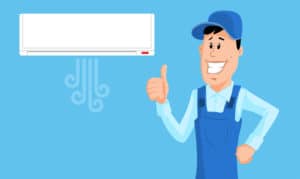Is My Indoor Air Quality Worse Than My Outdoor Air Quality?
With the rise of industrialization and urbanization, air quality has become an ever-growing concern across the world. Outside, emissions from manufacturing plants, automobiles and other man-made sources have contributed to small but significant changes in the chemical composition of the air in many developed and developing regions. However, air quality is not only an outdoor issue. Your indoor air quality is likely significantly worse than the outdoor air quality. Indoors, many factors can contribute to poor air quality, which can in turn contribute to human health issues.
In this guide, our experts here at 1-800-anytyme discuss indoor quality — how it’s affected and contaminated, the risks it poses to your health, and steps property owners can take to mitigate that risk. We also provide information on our very own professional indoor air quality services.

Indoor Air Quality: The Truth
While we often think of air quality as an outdoor issue, the truth is that the air inside our buildings can be. As the Environmental Protection Agency (EPA) reports: “In the last several years, a growing body of scientific evidence has indicated that the air within homes and other buildings can be more seriously polluted than the outdoor air in even the largest and most industrialized cities.” Furthermore, as most people spend the bulk of their time indoors, it is indoor quality that has the larger influence on human health.
What Are The Causes?
Poor indoor air quality is the result of microscopic contaminants in the air supply. These contaminants include a host of synthetic chemicals, molds, bacteria, dust, burnt material, and many other substances. They can come from many sources, including:
- Fuel-burning combustion appliances, such as stoves, grills, furnaces, water heaters and fireplaces
- Tobacco products
- Building materials and furnishings—including asbestos insulation, newly installed flooring, carpet, or upholstery; and cabinetry or furniture made of certain pressed wood products
- Chemical products for household cleaning and maintenance, personal care, or hobbies
- Central heating and cooling systems and humidification devices; namely those that are not regularly cleaned
- Excess moisture
- Outdoor sources such as radon, pesticides, and general outdoor air pollution
Can I Measure My Own Indoor Air Quality?
When inside your own home or workplace, it can be difficult to determine the quality of your air without mechanical assistance. In fact, many families and businesses go years without realizing that the air inside their buildings is contaminated to a degree that can cause health problems. In recent years, technology has been designed so that we can track our indoor air quality for a reasonably priced device and an easily accessible app. For $130 – $260, you can purchase an air quality monitor. This small device is placed in the environment you wish to measure. Accurate, live data transmits to your phone, allowing you to keep track of the air quality, particulate matter, temperature, humidity and chemical pollutants in your home or business.
How Can I Improve My Indoor Air Quality?
Now that you know the quality of your air, what can you do to improve your indoor air quality? Whether you have received less-than-desirable results from your air quality monitor or you are simply trying to preserve your indoor air, there are steps you can take to ensure that you have the highest indoor air quality possible.
What you need:
- An electronic air filter
- An air scrubber
- A clean duct system
The electronic air filter catches particulates too large to pass through the filter material. The filter media is electronically charged, attracting smaller particulates to stick to it. This makes the whole system even more effective.
The air scrubber uses a process called photo-catalytic-oxidation to clump smaller particulates together. This means that any microscopic particulates that got through the electronic filter clump together once they reach the air scrubber. They then become larger particulates. This allows them to get caught in the electronic air filter the second time they cycle through your environment.
Furthermore, the air scrubber will render the remaining air contaminants inactive, killing mold, odors and other harmful substances. Not only will clean air be returned to your environment, but it will also transform the contaminants into oxidizers which return to seek out contaminants. They destroy and sanitize the surfaces in your home or business.
For the electronic air filter and air scrubber to be most effective, you need a clean duct system. The commonly used flexible duct systems today are structured in a way that is not very accessible for cleaning purposes. Therefore, the best solution is to install a new closed duct system that isn’t contaminated yet.
Together, these three components can create a significant positive change to the indoor air quality of your environment.
Learn More and Contact Us
Want to learn more about indoor air quality? Ready to schedule installation or replacement services with our team here at 1-800-anytyme? Contact us today to discuss improving your air quality here or call (760) 477-0072 to get in touch with our professionals and schedule an appointment today!
